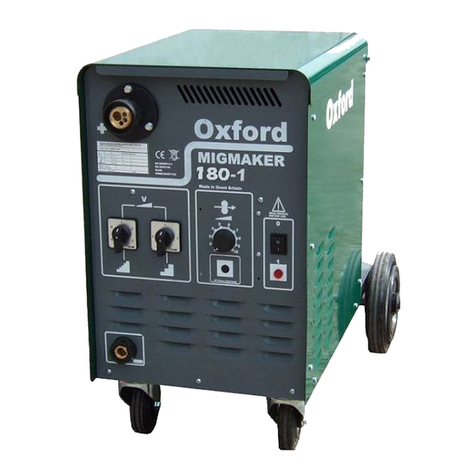MIG welding basics
The normal process of MIG welding involves an electric arc, a consumable wire and a
shielding gas.
The electrical arc creates the heat which melts both the welding wire and the material being
welded, the result is a weld pool which is protected from the atmosphere by the shielding gas,
or by flux if using a special gas-less wire. Without the shielding gas oxygen, other gases
would contaminate the weld pool to create a weak porous unusable weld.
The welding current used for MIG welding is DC (direct current).
The output characteristics of most MIG welding machines is of the constant voltage type (CV).
Therefore, when the voltage has been selected on themachine its value remains fairly
constant, only dropping a little with increasing current draw.
For the vast majority of MIG welding the electrode (wire) is positive potential with the work
being negative.
MIG welding below 250A is normally carried out in dip transfer mode this means that the wire
is constantly dipping into the welding pool & burning back which creates a stable crackle or
buzzing sound if set up correctly. MIG welding above 250A is done in spray transfer mode,
where the wire constantly burns off into the weld pool without constantly dipping into the pool.
This results in a more stable quiet arc.
Every machine has a certain level of inductance in its output circuit. This inductance greatly
affects the welding performance of the machine when welding in dip transfer mode below
250A. Too high a value would result in a hot unstable arc, too low a value would give rise to
excess splatter and a cold poorly penetrating weld.
The amount of inductance on this machine can be varied using the ARC TUNE control. The
higher the weld power, generally the more inductance is required. By varying the inductance,
the amount of splatter produced in the weld can be reduced to a minimum to give a nice clean
weld.
The welding voltage selection on all models of machines is the main control of the actual heat
input into the welding pool, the higher the volts the more power.
MIG welding voltage range is from 14v to 44v.
The wire speed control and the wire size selected both affect the actual value of welding
current achieved at a given welding voltage.
Gas
The gas used for MIG welding can vary from 100% to co2 to mixtures of argon and co2, to
pure argon with other special applications gases also available. The choice of gas depends
upon the material being welded. For mild steel welding pure co2 can be used however it gives
a cold and splattery weld and is not particularly nice to use. Argon with co2 content between
5% and 20% generally gives the best results, pure argon results in an arc which is flary & too
hot for mild steel. For stainless steels and aluminium welding pure argon is normally used,
however some specialist gases such as helium mixtures are available from gas outlets which
may sometimes give benefits, consult your local gas specialist for further information.
The correct gas flow is essential, too little flow can result in a porous weak weld, too much
and the arc can become unstable and harsh.
The gas flow should be set on the regulator or flow meter to suit the welding conditions;
higher welding current needs a higher gas flow, the correct flow rates are between 2-25 litres
per min. Start with a very low flow rate, as a guide you should be able to only just hear the
gas flowing from the nozzle when pulling the torch switch.
Never try to use a gas not intended for MIG welding
MIG wire
The MIG welding wire used is generally selected to be very similar to the material being
welded, for instance to weld stainless steel you would not use a mild steel wire and so on.
The diameter of MIG welding wire should be selected according to the power and thickness of
material being welded. 0.8mm wire is the smallest recommended size & is suitable for
between 30 and 180amps for automotive & light fabrication or maintenance.
1.0mm wire covers the range from about 80amps to 250amps (repairs + medium fabrication).
1.2mm would be suitable from 250amps to 450amps (heavy fabrication).
1.6mm & 2.4mm are for the very heaviest fabrication applications above 350amps.
The above sizes and current ranges are approximate only, as many other factors need to be
considered such as the gas used, the material being welded etc.
Always keep the MIG wire dry & rust free, do not use if the wire is rusty




























